Reflective Practice Essay: Wound Care Experience and Lessons Learned
VerifiedAdded on 2022/08/22
|13
|3653
|62
Essay
AI Summary
This reflective essay, written by a nursing student, details an episode of care involving wound management in an emergency ward setting. The essay uses Rolfe's reflective model to analyze the experience of providing wound care to a patient with a chronic foot wound, including wound assessment, dressing changes, and patient communication. It explores the student's application of aseptic techniques, adherence to patient privacy, and the importance of informed consent. The essay highlights key learnings, such as the TIME framework for wound assessment and the significance of appropriate dressings. The student reflects on what went well, identifies areas for improvement, and outlines a plan for enhancing wound management skills, emphasizing the importance of continuous professional development and evidence-based practice in nursing. The essay also emphasizes the relevance of the experience to the Nursing and Midwifery Council (NMC) professional standards, underscoring the value of reflective practice in bridging the gap between theory and practical application, and promoting improved patient outcomes.
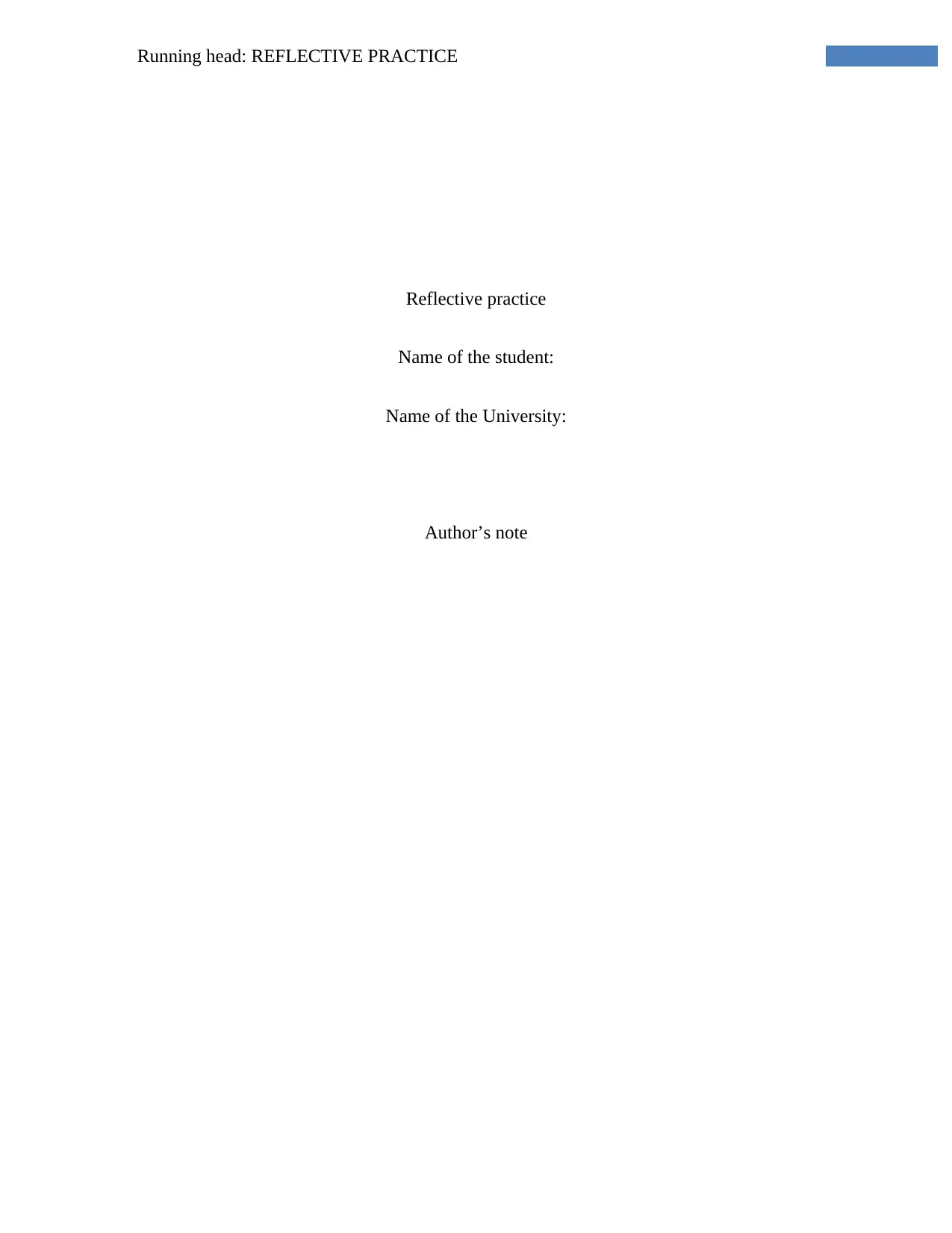
Running head: REFLECTIVE PRACTICE
Reflective practice
Name of the student:
Name of the University:
Author’s note
Reflective practice
Name of the student:
Name of the University:
Author’s note
Paraphrase This Document
Need a fresh take? Get an instant paraphrase of this document with our AI Paraphraser
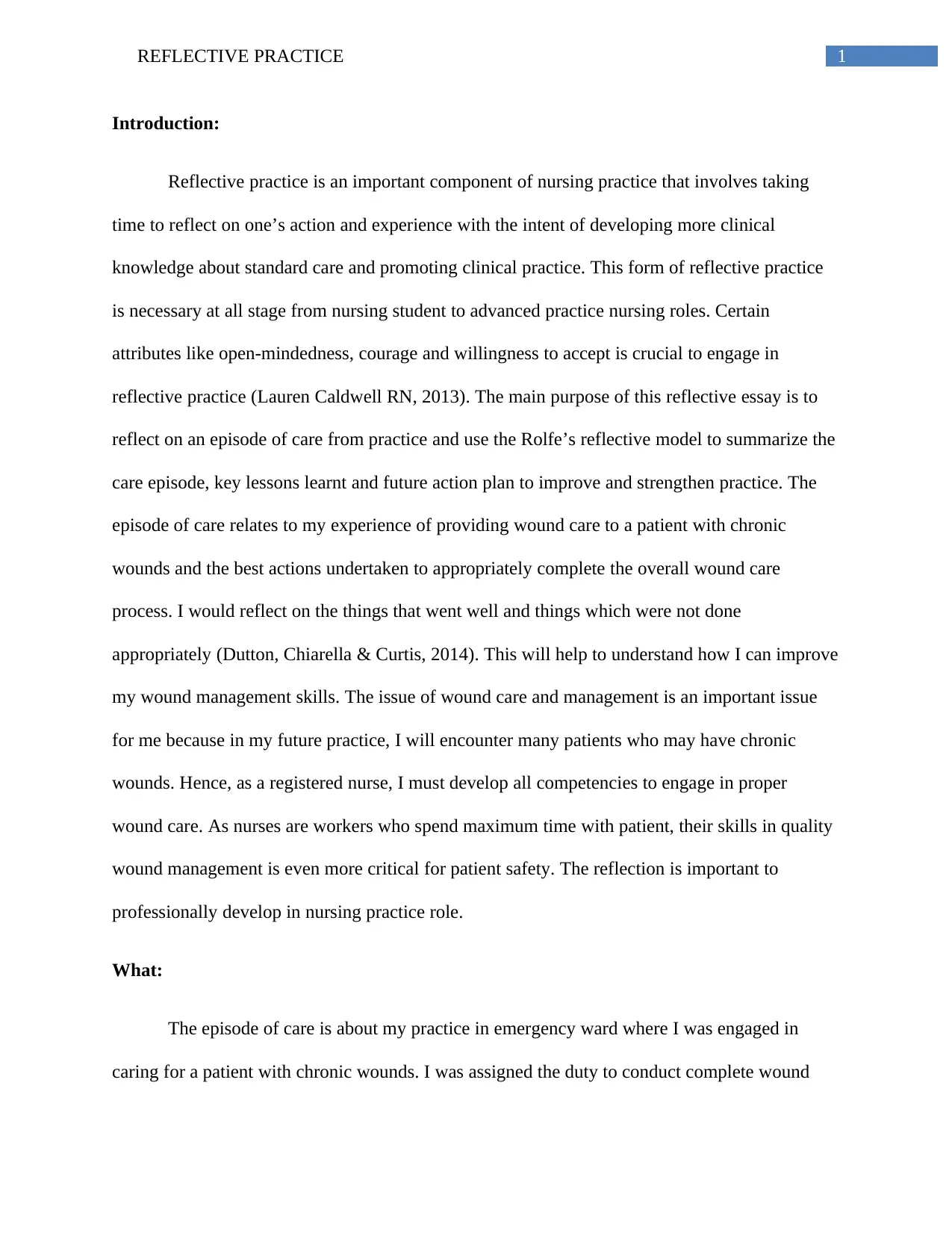
1REFLECTIVE PRACTICE
Introduction:
Reflective practice is an important component of nursing practice that involves taking
time to reflect on one’s action and experience with the intent of developing more clinical
knowledge about standard care and promoting clinical practice. This form of reflective practice
is necessary at all stage from nursing student to advanced practice nursing roles. Certain
attributes like open-mindedness, courage and willingness to accept is crucial to engage in
reflective practice (Lauren Caldwell RN, 2013). The main purpose of this reflective essay is to
reflect on an episode of care from practice and use the Rolfe’s reflective model to summarize the
care episode, key lessons learnt and future action plan to improve and strengthen practice. The
episode of care relates to my experience of providing wound care to a patient with chronic
wounds and the best actions undertaken to appropriately complete the overall wound care
process. I would reflect on the things that went well and things which were not done
appropriately (Dutton, Chiarella & Curtis, 2014). This will help to understand how I can improve
my wound management skills. The issue of wound care and management is an important issue
for me because in my future practice, I will encounter many patients who may have chronic
wounds. Hence, as a registered nurse, I must develop all competencies to engage in proper
wound care. As nurses are workers who spend maximum time with patient, their skills in quality
wound management is even more critical for patient safety. The reflection is important to
professionally develop in nursing practice role.
What:
The episode of care is about my practice in emergency ward where I was engaged in
caring for a patient with chronic wounds. I was assigned the duty to conduct complete wound
Introduction:
Reflective practice is an important component of nursing practice that involves taking
time to reflect on one’s action and experience with the intent of developing more clinical
knowledge about standard care and promoting clinical practice. This form of reflective practice
is necessary at all stage from nursing student to advanced practice nursing roles. Certain
attributes like open-mindedness, courage and willingness to accept is crucial to engage in
reflective practice (Lauren Caldwell RN, 2013). The main purpose of this reflective essay is to
reflect on an episode of care from practice and use the Rolfe’s reflective model to summarize the
care episode, key lessons learnt and future action plan to improve and strengthen practice. The
episode of care relates to my experience of providing wound care to a patient with chronic
wounds and the best actions undertaken to appropriately complete the overall wound care
process. I would reflect on the things that went well and things which were not done
appropriately (Dutton, Chiarella & Curtis, 2014). This will help to understand how I can improve
my wound management skills. The issue of wound care and management is an important issue
for me because in my future practice, I will encounter many patients who may have chronic
wounds. Hence, as a registered nurse, I must develop all competencies to engage in proper
wound care. As nurses are workers who spend maximum time with patient, their skills in quality
wound management is even more critical for patient safety. The reflection is important to
professionally develop in nursing practice role.
What:
The episode of care is about my practice in emergency ward where I was engaged in
caring for a patient with chronic wounds. I was assigned the duty to conduct complete wound
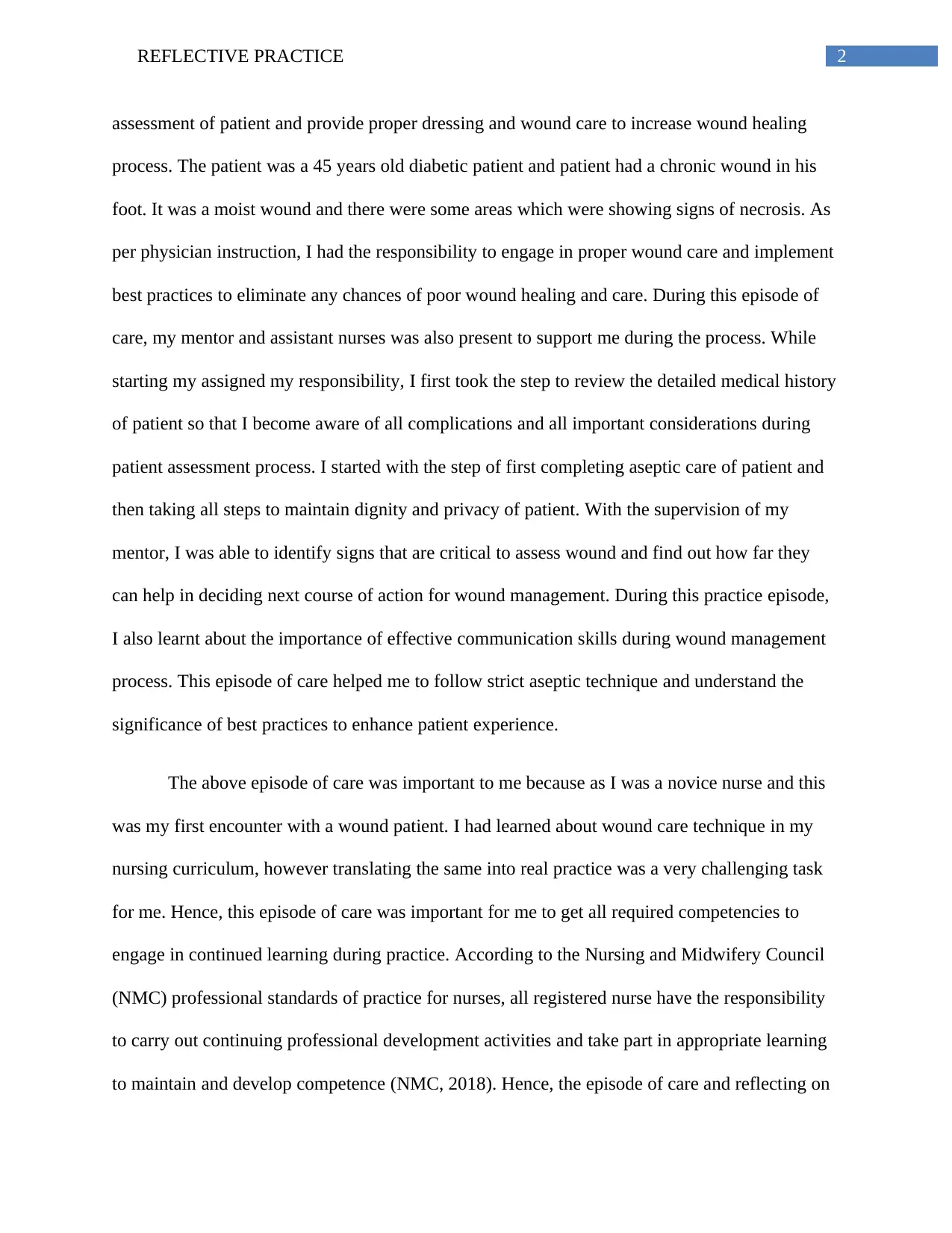
2REFLECTIVE PRACTICE
assessment of patient and provide proper dressing and wound care to increase wound healing
process. The patient was a 45 years old diabetic patient and patient had a chronic wound in his
foot. It was a moist wound and there were some areas which were showing signs of necrosis. As
per physician instruction, I had the responsibility to engage in proper wound care and implement
best practices to eliminate any chances of poor wound healing and care. During this episode of
care, my mentor and assistant nurses was also present to support me during the process. While
starting my assigned my responsibility, I first took the step to review the detailed medical history
of patient so that I become aware of all complications and all important considerations during
patient assessment process. I started with the step of first completing aseptic care of patient and
then taking all steps to maintain dignity and privacy of patient. With the supervision of my
mentor, I was able to identify signs that are critical to assess wound and find out how far they
can help in deciding next course of action for wound management. During this practice episode,
I also learnt about the importance of effective communication skills during wound management
process. This episode of care helped me to follow strict aseptic technique and understand the
significance of best practices to enhance patient experience.
The above episode of care was important to me because as I was a novice nurse and this
was my first encounter with a wound patient. I had learned about wound care technique in my
nursing curriculum, however translating the same into real practice was a very challenging task
for me. Hence, this episode of care was important for me to get all required competencies to
engage in continued learning during practice. According to the Nursing and Midwifery Council
(NMC) professional standards of practice for nurses, all registered nurse have the responsibility
to carry out continuing professional development activities and take part in appropriate learning
to maintain and develop competence (NMC, 2018). Hence, the episode of care and reflecting on
assessment of patient and provide proper dressing and wound care to increase wound healing
process. The patient was a 45 years old diabetic patient and patient had a chronic wound in his
foot. It was a moist wound and there were some areas which were showing signs of necrosis. As
per physician instruction, I had the responsibility to engage in proper wound care and implement
best practices to eliminate any chances of poor wound healing and care. During this episode of
care, my mentor and assistant nurses was also present to support me during the process. While
starting my assigned my responsibility, I first took the step to review the detailed medical history
of patient so that I become aware of all complications and all important considerations during
patient assessment process. I started with the step of first completing aseptic care of patient and
then taking all steps to maintain dignity and privacy of patient. With the supervision of my
mentor, I was able to identify signs that are critical to assess wound and find out how far they
can help in deciding next course of action for wound management. During this practice episode,
I also learnt about the importance of effective communication skills during wound management
process. This episode of care helped me to follow strict aseptic technique and understand the
significance of best practices to enhance patient experience.
The above episode of care was important to me because as I was a novice nurse and this
was my first encounter with a wound patient. I had learned about wound care technique in my
nursing curriculum, however translating the same into real practice was a very challenging task
for me. Hence, this episode of care was important for me to get all required competencies to
engage in continued learning during practice. According to the Nursing and Midwifery Council
(NMC) professional standards of practice for nurses, all registered nurse have the responsibility
to carry out continuing professional development activities and take part in appropriate learning
to maintain and develop competence (NMC, 2018). Hence, the episode of care and reflecting on
⊘ This is a preview!⊘
Do you want full access?
Subscribe today to unlock all pages.

Trusted by 1+ million students worldwide
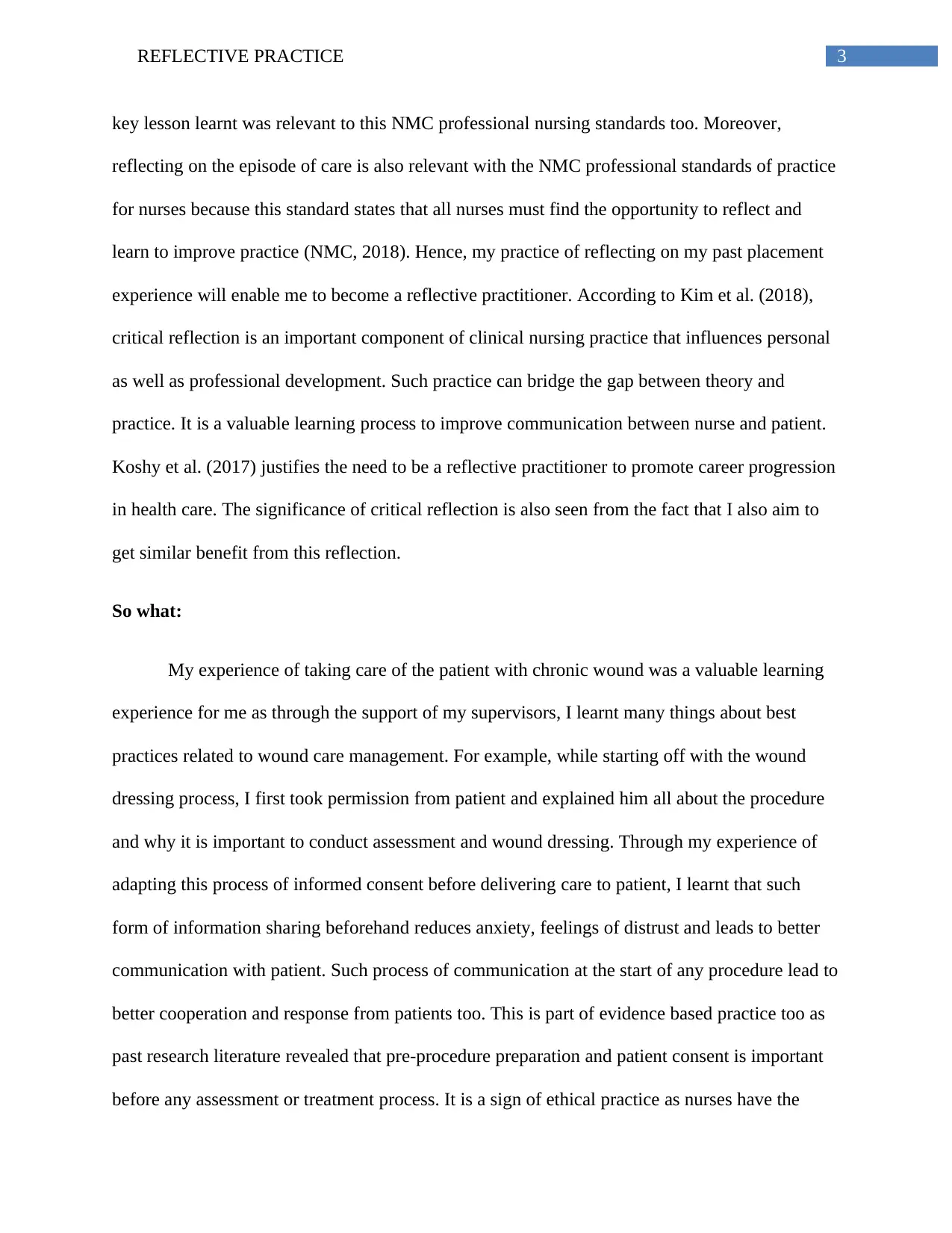
3REFLECTIVE PRACTICE
key lesson learnt was relevant to this NMC professional nursing standards too. Moreover,
reflecting on the episode of care is also relevant with the NMC professional standards of practice
for nurses because this standard states that all nurses must find the opportunity to reflect and
learn to improve practice (NMC, 2018). Hence, my practice of reflecting on my past placement
experience will enable me to become a reflective practitioner. According to Kim et al. (2018),
critical reflection is an important component of clinical nursing practice that influences personal
as well as professional development. Such practice can bridge the gap between theory and
practice. It is a valuable learning process to improve communication between nurse and patient.
Koshy et al. (2017) justifies the need to be a reflective practitioner to promote career progression
in health care. The significance of critical reflection is also seen from the fact that I also aim to
get similar benefit from this reflection.
So what:
My experience of taking care of the patient with chronic wound was a valuable learning
experience for me as through the support of my supervisors, I learnt many things about best
practices related to wound care management. For example, while starting off with the wound
dressing process, I first took permission from patient and explained him all about the procedure
and why it is important to conduct assessment and wound dressing. Through my experience of
adapting this process of informed consent before delivering care to patient, I learnt that such
form of information sharing beforehand reduces anxiety, feelings of distrust and leads to better
communication with patient. Such process of communication at the start of any procedure lead to
better cooperation and response from patients too. This is part of evidence based practice too as
past research literature revealed that pre-procedure preparation and patient consent is important
before any assessment or treatment process. It is a sign of ethical practice as nurses have the
key lesson learnt was relevant to this NMC professional nursing standards too. Moreover,
reflecting on the episode of care is also relevant with the NMC professional standards of practice
for nurses because this standard states that all nurses must find the opportunity to reflect and
learn to improve practice (NMC, 2018). Hence, my practice of reflecting on my past placement
experience will enable me to become a reflective practitioner. According to Kim et al. (2018),
critical reflection is an important component of clinical nursing practice that influences personal
as well as professional development. Such practice can bridge the gap between theory and
practice. It is a valuable learning process to improve communication between nurse and patient.
Koshy et al. (2017) justifies the need to be a reflective practitioner to promote career progression
in health care. The significance of critical reflection is also seen from the fact that I also aim to
get similar benefit from this reflection.
So what:
My experience of taking care of the patient with chronic wound was a valuable learning
experience for me as through the support of my supervisors, I learnt many things about best
practices related to wound care management. For example, while starting off with the wound
dressing process, I first took permission from patient and explained him all about the procedure
and why it is important to conduct assessment and wound dressing. Through my experience of
adapting this process of informed consent before delivering care to patient, I learnt that such
form of information sharing beforehand reduces anxiety, feelings of distrust and leads to better
communication with patient. Such process of communication at the start of any procedure lead to
better cooperation and response from patients too. This is part of evidence based practice too as
past research literature revealed that pre-procedure preparation and patient consent is important
before any assessment or treatment process. It is a sign of ethical practice as nurses have the
Paraphrase This Document
Need a fresh take? Get an instant paraphrase of this document with our AI Paraphraser
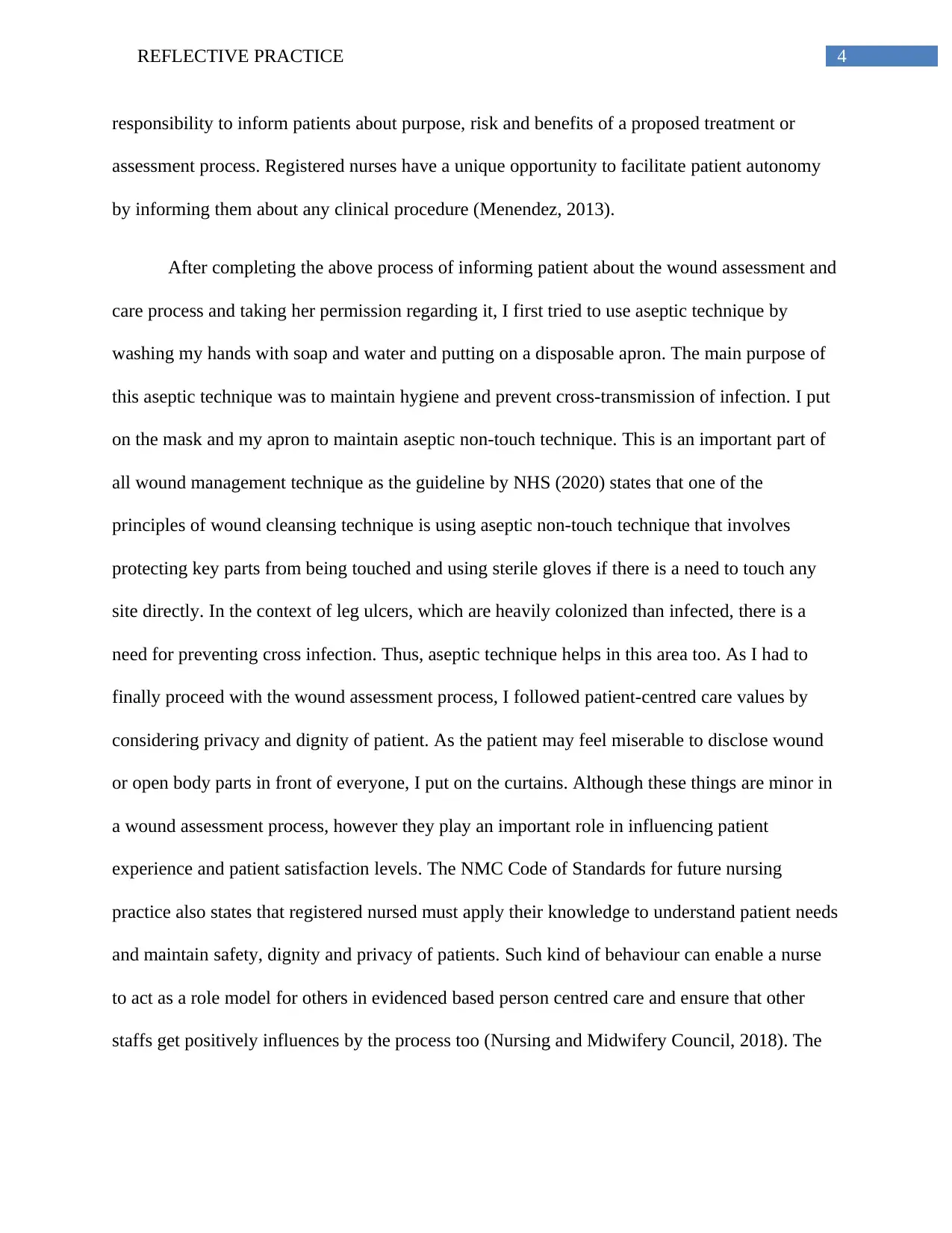
4REFLECTIVE PRACTICE
responsibility to inform patients about purpose, risk and benefits of a proposed treatment or
assessment process. Registered nurses have a unique opportunity to facilitate patient autonomy
by informing them about any clinical procedure (Menendez, 2013).
After completing the above process of informing patient about the wound assessment and
care process and taking her permission regarding it, I first tried to use aseptic technique by
washing my hands with soap and water and putting on a disposable apron. The main purpose of
this aseptic technique was to maintain hygiene and prevent cross-transmission of infection. I put
on the mask and my apron to maintain aseptic non-touch technique. This is an important part of
all wound management technique as the guideline by NHS (2020) states that one of the
principles of wound cleansing technique is using aseptic non-touch technique that involves
protecting key parts from being touched and using sterile gloves if there is a need to touch any
site directly. In the context of leg ulcers, which are heavily colonized than infected, there is a
need for preventing cross infection. Thus, aseptic technique helps in this area too. As I had to
finally proceed with the wound assessment process, I followed patient-centred care values by
considering privacy and dignity of patient. As the patient may feel miserable to disclose wound
or open body parts in front of everyone, I put on the curtains. Although these things are minor in
a wound assessment process, however they play an important role in influencing patient
experience and patient satisfaction levels. The NMC Code of Standards for future nursing
practice also states that registered nursed must apply their knowledge to understand patient needs
and maintain safety, dignity and privacy of patients. Such kind of behaviour can enable a nurse
to act as a role model for others in evidenced based person centred care and ensure that other
staffs get positively influences by the process too (Nursing and Midwifery Council, 2018). The
responsibility to inform patients about purpose, risk and benefits of a proposed treatment or
assessment process. Registered nurses have a unique opportunity to facilitate patient autonomy
by informing them about any clinical procedure (Menendez, 2013).
After completing the above process of informing patient about the wound assessment and
care process and taking her permission regarding it, I first tried to use aseptic technique by
washing my hands with soap and water and putting on a disposable apron. The main purpose of
this aseptic technique was to maintain hygiene and prevent cross-transmission of infection. I put
on the mask and my apron to maintain aseptic non-touch technique. This is an important part of
all wound management technique as the guideline by NHS (2020) states that one of the
principles of wound cleansing technique is using aseptic non-touch technique that involves
protecting key parts from being touched and using sterile gloves if there is a need to touch any
site directly. In the context of leg ulcers, which are heavily colonized than infected, there is a
need for preventing cross infection. Thus, aseptic technique helps in this area too. As I had to
finally proceed with the wound assessment process, I followed patient-centred care values by
considering privacy and dignity of patient. As the patient may feel miserable to disclose wound
or open body parts in front of everyone, I put on the curtains. Although these things are minor in
a wound assessment process, however they play an important role in influencing patient
experience and patient satisfaction levels. The NMC Code of Standards for future nursing
practice also states that registered nursed must apply their knowledge to understand patient needs
and maintain safety, dignity and privacy of patients. Such kind of behaviour can enable a nurse
to act as a role model for others in evidenced based person centred care and ensure that other
staffs get positively influences by the process too (Nursing and Midwifery Council, 2018). The
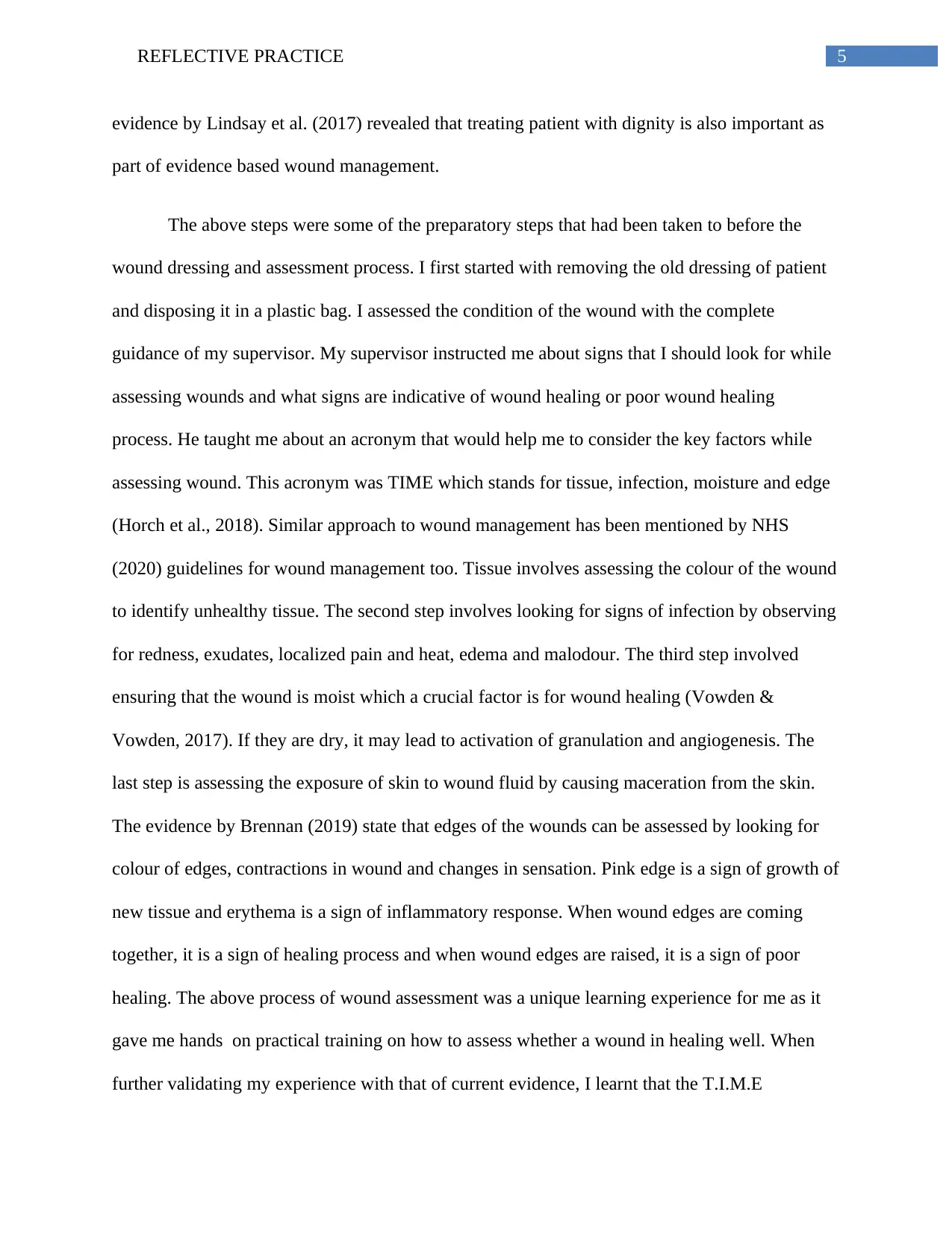
5REFLECTIVE PRACTICE
evidence by Lindsay et al. (2017) revealed that treating patient with dignity is also important as
part of evidence based wound management.
The above steps were some of the preparatory steps that had been taken to before the
wound dressing and assessment process. I first started with removing the old dressing of patient
and disposing it in a plastic bag. I assessed the condition of the wound with the complete
guidance of my supervisor. My supervisor instructed me about signs that I should look for while
assessing wounds and what signs are indicative of wound healing or poor wound healing
process. He taught me about an acronym that would help me to consider the key factors while
assessing wound. This acronym was TIME which stands for tissue, infection, moisture and edge
(Horch et al., 2018). Similar approach to wound management has been mentioned by NHS
(2020) guidelines for wound management too. Tissue involves assessing the colour of the wound
to identify unhealthy tissue. The second step involves looking for signs of infection by observing
for redness, exudates, localized pain and heat, edema and malodour. The third step involved
ensuring that the wound is moist which a crucial factor is for wound healing (Vowden &
Vowden, 2017). If they are dry, it may lead to activation of granulation and angiogenesis. The
last step is assessing the exposure of skin to wound fluid by causing maceration from the skin.
The evidence by Brennan (2019) state that edges of the wounds can be assessed by looking for
colour of edges, contractions in wound and changes in sensation. Pink edge is a sign of growth of
new tissue and erythema is a sign of inflammatory response. When wound edges are coming
together, it is a sign of healing process and when wound edges are raised, it is a sign of poor
healing. The above process of wound assessment was a unique learning experience for me as it
gave me hands on practical training on how to assess whether a wound in healing well. When
further validating my experience with that of current evidence, I learnt that the T.I.M.E
evidence by Lindsay et al. (2017) revealed that treating patient with dignity is also important as
part of evidence based wound management.
The above steps were some of the preparatory steps that had been taken to before the
wound dressing and assessment process. I first started with removing the old dressing of patient
and disposing it in a plastic bag. I assessed the condition of the wound with the complete
guidance of my supervisor. My supervisor instructed me about signs that I should look for while
assessing wounds and what signs are indicative of wound healing or poor wound healing
process. He taught me about an acronym that would help me to consider the key factors while
assessing wound. This acronym was TIME which stands for tissue, infection, moisture and edge
(Horch et al., 2018). Similar approach to wound management has been mentioned by NHS
(2020) guidelines for wound management too. Tissue involves assessing the colour of the wound
to identify unhealthy tissue. The second step involves looking for signs of infection by observing
for redness, exudates, localized pain and heat, edema and malodour. The third step involved
ensuring that the wound is moist which a crucial factor is for wound healing (Vowden &
Vowden, 2017). If they are dry, it may lead to activation of granulation and angiogenesis. The
last step is assessing the exposure of skin to wound fluid by causing maceration from the skin.
The evidence by Brennan (2019) state that edges of the wounds can be assessed by looking for
colour of edges, contractions in wound and changes in sensation. Pink edge is a sign of growth of
new tissue and erythema is a sign of inflammatory response. When wound edges are coming
together, it is a sign of healing process and when wound edges are raised, it is a sign of poor
healing. The above process of wound assessment was a unique learning experience for me as it
gave me hands on practical training on how to assess whether a wound in healing well. When
further validating my experience with that of current evidence, I learnt that the T.I.M.E
⊘ This is a preview!⊘
Do you want full access?
Subscribe today to unlock all pages.

Trusted by 1+ million students worldwide
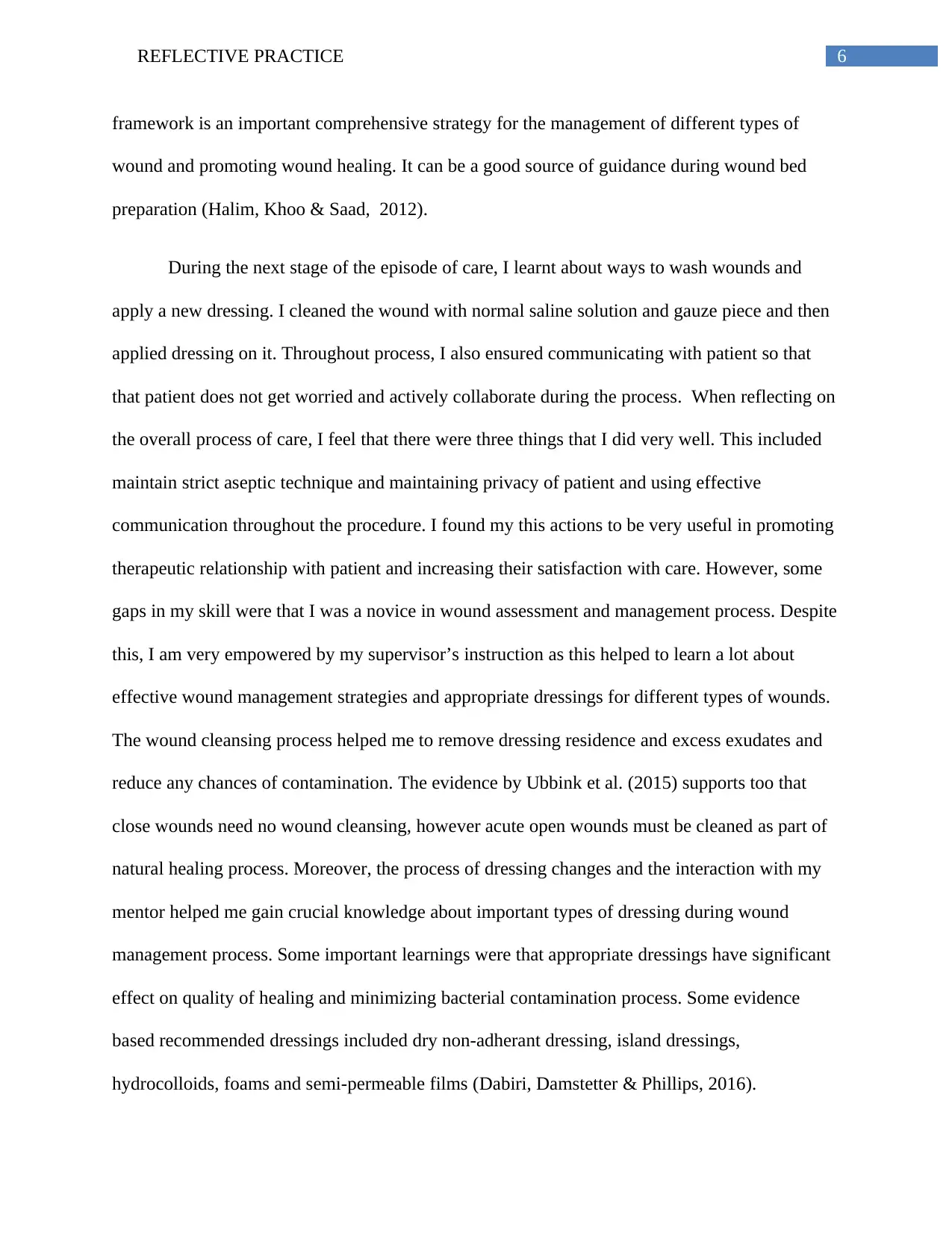
6REFLECTIVE PRACTICE
framework is an important comprehensive strategy for the management of different types of
wound and promoting wound healing. It can be a good source of guidance during wound bed
preparation (Halim, Khoo & Saad, 2012).
During the next stage of the episode of care, I learnt about ways to wash wounds and
apply a new dressing. I cleaned the wound with normal saline solution and gauze piece and then
applied dressing on it. Throughout process, I also ensured communicating with patient so that
that patient does not get worried and actively collaborate during the process. When reflecting on
the overall process of care, I feel that there were three things that I did very well. This included
maintain strict aseptic technique and maintaining privacy of patient and using effective
communication throughout the procedure. I found my this actions to be very useful in promoting
therapeutic relationship with patient and increasing their satisfaction with care. However, some
gaps in my skill were that I was a novice in wound assessment and management process. Despite
this, I am very empowered by my supervisor’s instruction as this helped to learn a lot about
effective wound management strategies and appropriate dressings for different types of wounds.
The wound cleansing process helped me to remove dressing residence and excess exudates and
reduce any chances of contamination. The evidence by Ubbink et al. (2015) supports too that
close wounds need no wound cleansing, however acute open wounds must be cleaned as part of
natural healing process. Moreover, the process of dressing changes and the interaction with my
mentor helped me gain crucial knowledge about important types of dressing during wound
management process. Some important learnings were that appropriate dressings have significant
effect on quality of healing and minimizing bacterial contamination process. Some evidence
based recommended dressings included dry non-adherant dressing, island dressings,
hydrocolloids, foams and semi-permeable films (Dabiri, Damstetter & Phillips, 2016).
framework is an important comprehensive strategy for the management of different types of
wound and promoting wound healing. It can be a good source of guidance during wound bed
preparation (Halim, Khoo & Saad, 2012).
During the next stage of the episode of care, I learnt about ways to wash wounds and
apply a new dressing. I cleaned the wound with normal saline solution and gauze piece and then
applied dressing on it. Throughout process, I also ensured communicating with patient so that
that patient does not get worried and actively collaborate during the process. When reflecting on
the overall process of care, I feel that there were three things that I did very well. This included
maintain strict aseptic technique and maintaining privacy of patient and using effective
communication throughout the procedure. I found my this actions to be very useful in promoting
therapeutic relationship with patient and increasing their satisfaction with care. However, some
gaps in my skill were that I was a novice in wound assessment and management process. Despite
this, I am very empowered by my supervisor’s instruction as this helped to learn a lot about
effective wound management strategies and appropriate dressings for different types of wounds.
The wound cleansing process helped me to remove dressing residence and excess exudates and
reduce any chances of contamination. The evidence by Ubbink et al. (2015) supports too that
close wounds need no wound cleansing, however acute open wounds must be cleaned as part of
natural healing process. Moreover, the process of dressing changes and the interaction with my
mentor helped me gain crucial knowledge about important types of dressing during wound
management process. Some important learnings were that appropriate dressings have significant
effect on quality of healing and minimizing bacterial contamination process. Some evidence
based recommended dressings included dry non-adherant dressing, island dressings,
hydrocolloids, foams and semi-permeable films (Dabiri, Damstetter & Phillips, 2016).
Paraphrase This Document
Need a fresh take? Get an instant paraphrase of this document with our AI Paraphraser
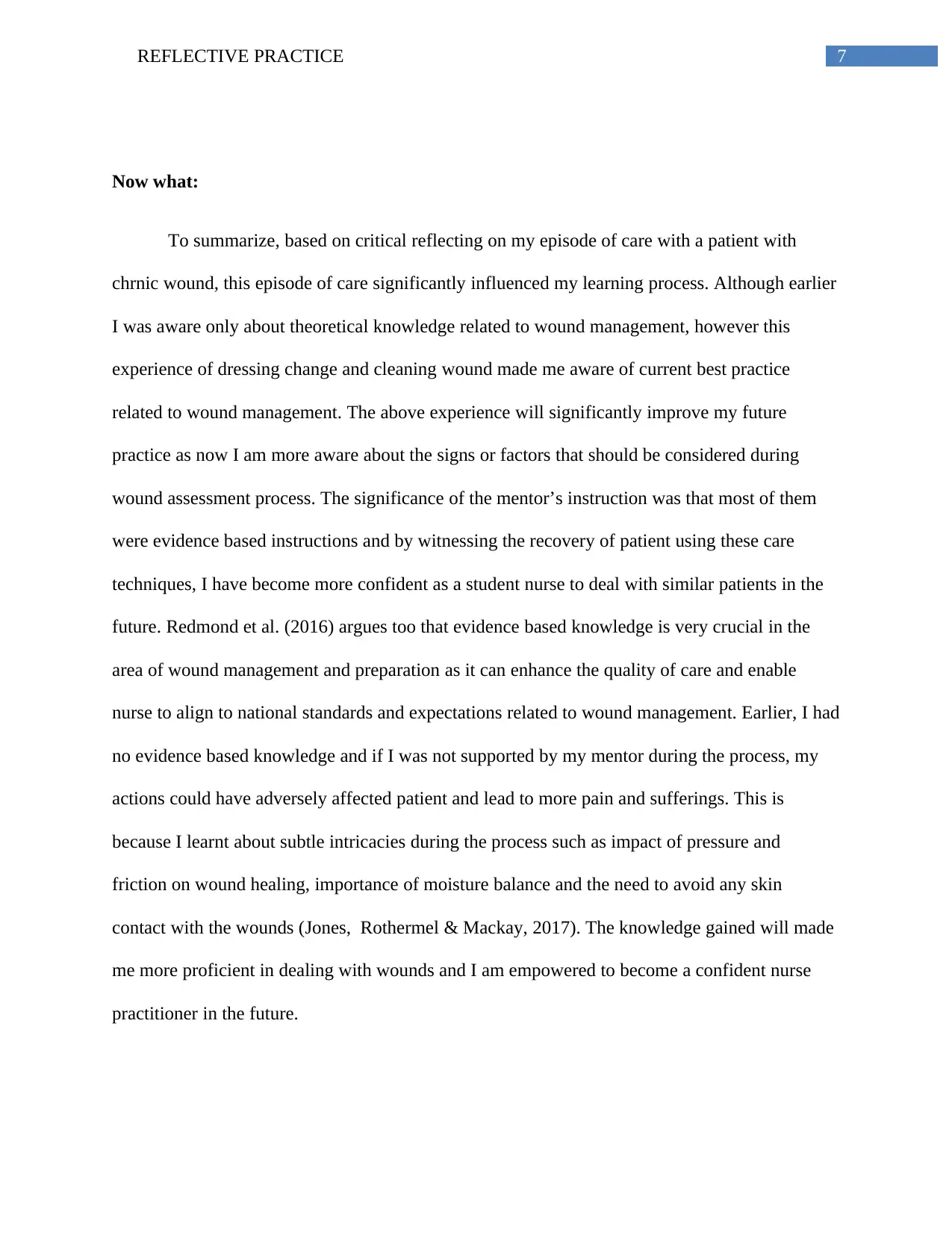
7REFLECTIVE PRACTICE
Now what:
To summarize, based on critical reflecting on my episode of care with a patient with
chrnic wound, this episode of care significantly influenced my learning process. Although earlier
I was aware only about theoretical knowledge related to wound management, however this
experience of dressing change and cleaning wound made me aware of current best practice
related to wound management. The above experience will significantly improve my future
practice as now I am more aware about the signs or factors that should be considered during
wound assessment process. The significance of the mentor’s instruction was that most of them
were evidence based instructions and by witnessing the recovery of patient using these care
techniques, I have become more confident as a student nurse to deal with similar patients in the
future. Redmond et al. (2016) argues too that evidence based knowledge is very crucial in the
area of wound management and preparation as it can enhance the quality of care and enable
nurse to align to national standards and expectations related to wound management. Earlier, I had
no evidence based knowledge and if I was not supported by my mentor during the process, my
actions could have adversely affected patient and lead to more pain and sufferings. This is
because I learnt about subtle intricacies during the process such as impact of pressure and
friction on wound healing, importance of moisture balance and the need to avoid any skin
contact with the wounds (Jones, Rothermel & Mackay, 2017). The knowledge gained will made
me more proficient in dealing with wounds and I am empowered to become a confident nurse
practitioner in the future.
Now what:
To summarize, based on critical reflecting on my episode of care with a patient with
chrnic wound, this episode of care significantly influenced my learning process. Although earlier
I was aware only about theoretical knowledge related to wound management, however this
experience of dressing change and cleaning wound made me aware of current best practice
related to wound management. The above experience will significantly improve my future
practice as now I am more aware about the signs or factors that should be considered during
wound assessment process. The significance of the mentor’s instruction was that most of them
were evidence based instructions and by witnessing the recovery of patient using these care
techniques, I have become more confident as a student nurse to deal with similar patients in the
future. Redmond et al. (2016) argues too that evidence based knowledge is very crucial in the
area of wound management and preparation as it can enhance the quality of care and enable
nurse to align to national standards and expectations related to wound management. Earlier, I had
no evidence based knowledge and if I was not supported by my mentor during the process, my
actions could have adversely affected patient and lead to more pain and sufferings. This is
because I learnt about subtle intricacies during the process such as impact of pressure and
friction on wound healing, importance of moisture balance and the need to avoid any skin
contact with the wounds (Jones, Rothermel & Mackay, 2017). The knowledge gained will made
me more proficient in dealing with wounds and I am empowered to become a confident nurse
practitioner in the future.
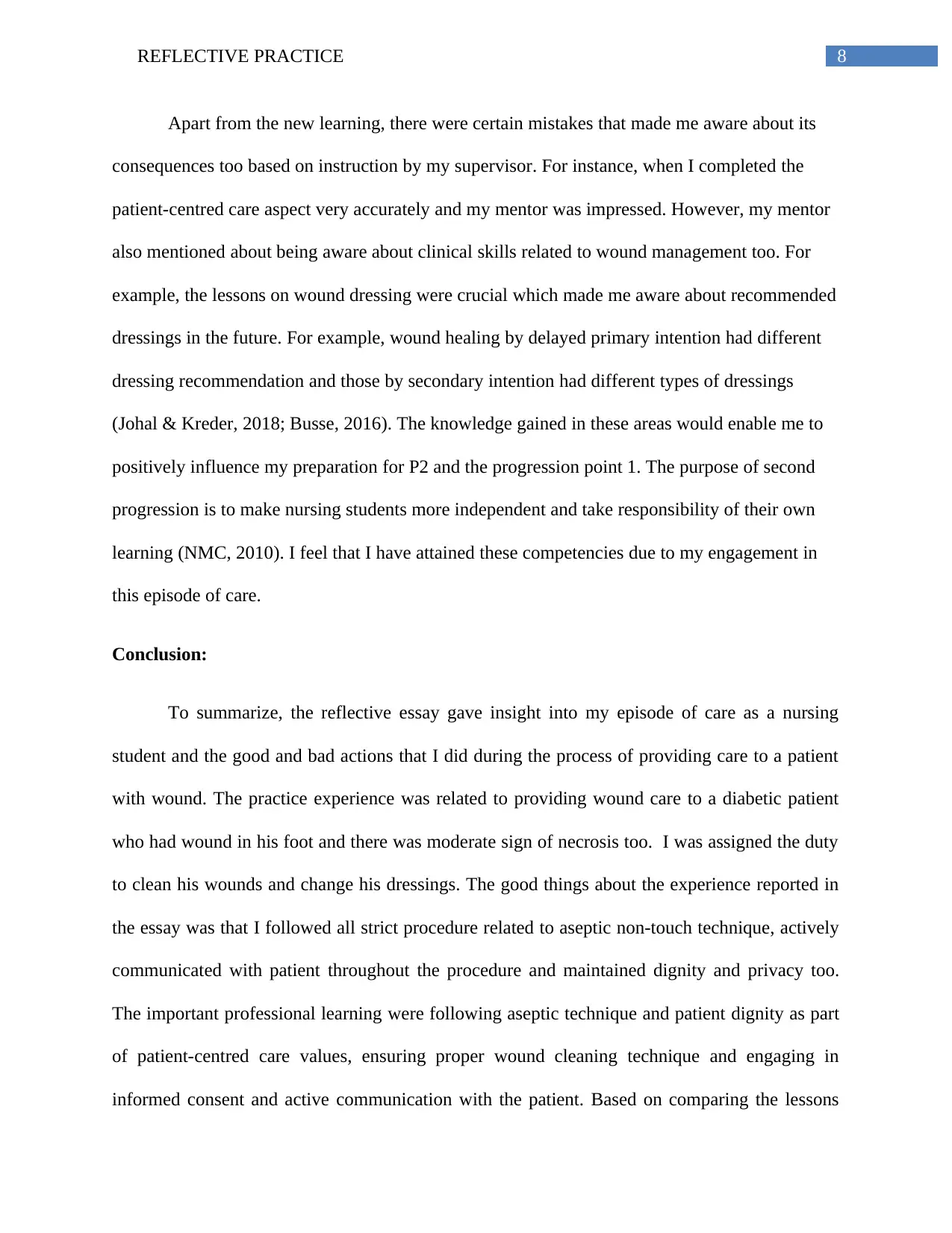
8REFLECTIVE PRACTICE
Apart from the new learning, there were certain mistakes that made me aware about its
consequences too based on instruction by my supervisor. For instance, when I completed the
patient-centred care aspect very accurately and my mentor was impressed. However, my mentor
also mentioned about being aware about clinical skills related to wound management too. For
example, the lessons on wound dressing were crucial which made me aware about recommended
dressings in the future. For example, wound healing by delayed primary intention had different
dressing recommendation and those by secondary intention had different types of dressings
(Johal & Kreder, 2018; Busse, 2016). The knowledge gained in these areas would enable me to
positively influence my preparation for P2 and the progression point 1. The purpose of second
progression is to make nursing students more independent and take responsibility of their own
learning (NMC, 2010). I feel that I have attained these competencies due to my engagement in
this episode of care.
Conclusion:
To summarize, the reflective essay gave insight into my episode of care as a nursing
student and the good and bad actions that I did during the process of providing care to a patient
with wound. The practice experience was related to providing wound care to a diabetic patient
who had wound in his foot and there was moderate sign of necrosis too. I was assigned the duty
to clean his wounds and change his dressings. The good things about the experience reported in
the essay was that I followed all strict procedure related to aseptic non-touch technique, actively
communicated with patient throughout the procedure and maintained dignity and privacy too.
The important professional learning were following aseptic technique and patient dignity as part
of patient-centred care values, ensuring proper wound cleaning technique and engaging in
informed consent and active communication with the patient. Based on comparing the lessons
Apart from the new learning, there were certain mistakes that made me aware about its
consequences too based on instruction by my supervisor. For instance, when I completed the
patient-centred care aspect very accurately and my mentor was impressed. However, my mentor
also mentioned about being aware about clinical skills related to wound management too. For
example, the lessons on wound dressing were crucial which made me aware about recommended
dressings in the future. For example, wound healing by delayed primary intention had different
dressing recommendation and those by secondary intention had different types of dressings
(Johal & Kreder, 2018; Busse, 2016). The knowledge gained in these areas would enable me to
positively influence my preparation for P2 and the progression point 1. The purpose of second
progression is to make nursing students more independent and take responsibility of their own
learning (NMC, 2010). I feel that I have attained these competencies due to my engagement in
this episode of care.
Conclusion:
To summarize, the reflective essay gave insight into my episode of care as a nursing
student and the good and bad actions that I did during the process of providing care to a patient
with wound. The practice experience was related to providing wound care to a diabetic patient
who had wound in his foot and there was moderate sign of necrosis too. I was assigned the duty
to clean his wounds and change his dressings. The good things about the experience reported in
the essay was that I followed all strict procedure related to aseptic non-touch technique, actively
communicated with patient throughout the procedure and maintained dignity and privacy too.
The important professional learning were following aseptic technique and patient dignity as part
of patient-centred care values, ensuring proper wound cleaning technique and engaging in
informed consent and active communication with the patient. Based on comparing the lessons
⊘ This is a preview!⊘
Do you want full access?
Subscribe today to unlock all pages.

Trusted by 1+ million students worldwide
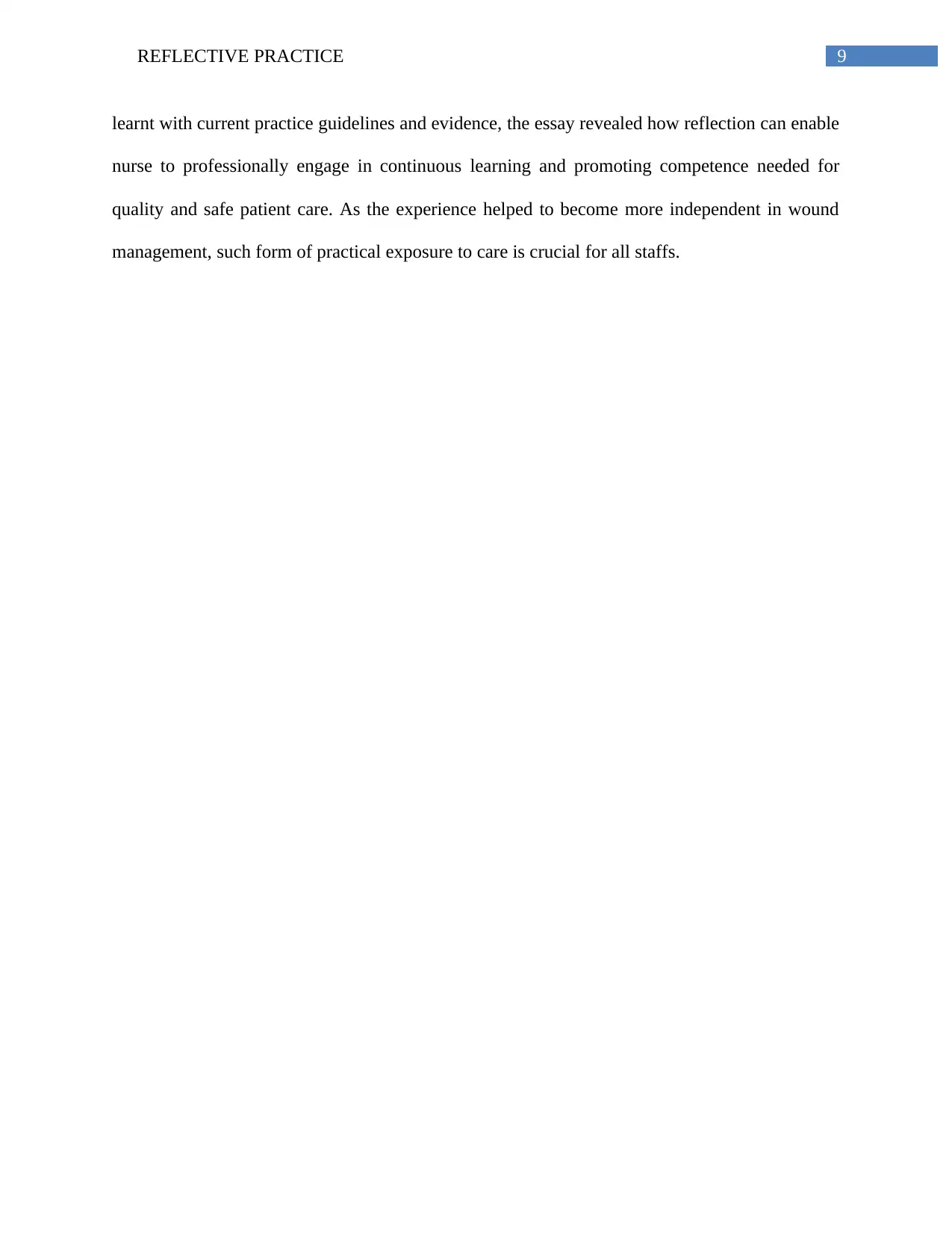
9REFLECTIVE PRACTICE
learnt with current practice guidelines and evidence, the essay revealed how reflection can enable
nurse to professionally engage in continuous learning and promoting competence needed for
quality and safe patient care. As the experience helped to become more independent in wound
management, such form of practical exposure to care is crucial for all staffs.
learnt with current practice guidelines and evidence, the essay revealed how reflection can enable
nurse to professionally engage in continuous learning and promoting competence needed for
quality and safe patient care. As the experience helped to become more independent in wound
management, such form of practical exposure to care is crucial for all staffs.
Paraphrase This Document
Need a fresh take? Get an instant paraphrase of this document with our AI Paraphraser
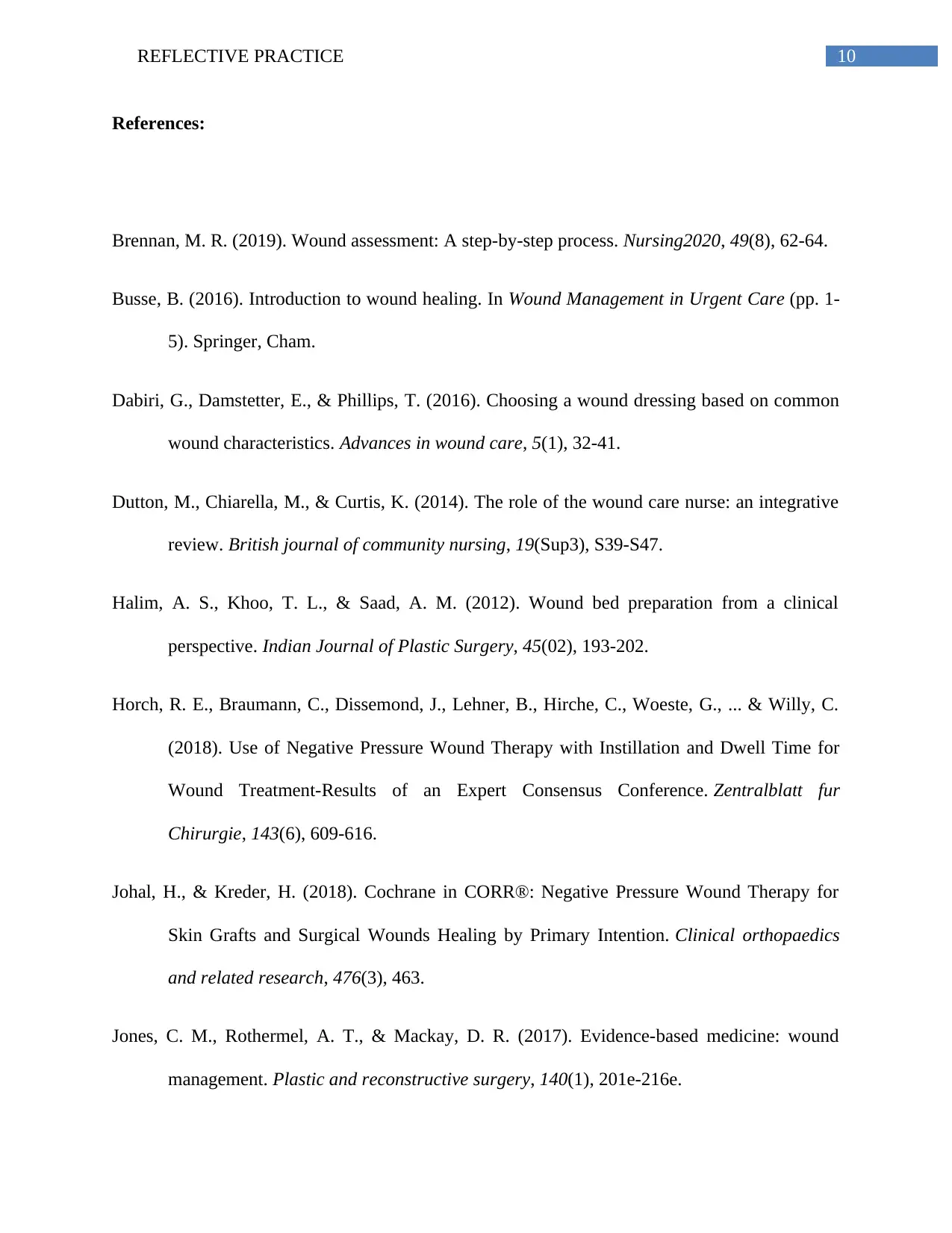
10REFLECTIVE PRACTICE
References:
Brennan, M. R. (2019). Wound assessment: A step-by-step process. Nursing2020, 49(8), 62-64.
Busse, B. (2016). Introduction to wound healing. In Wound Management in Urgent Care (pp. 1-
5). Springer, Cham.
Dabiri, G., Damstetter, E., & Phillips, T. (2016). Choosing a wound dressing based on common
wound characteristics. Advances in wound care, 5(1), 32-41.
Dutton, M., Chiarella, M., & Curtis, K. (2014). The role of the wound care nurse: an integrative
review. British journal of community nursing, 19(Sup3), S39-S47.
Halim, A. S., Khoo, T. L., & Saad, A. M. (2012). Wound bed preparation from a clinical
perspective. Indian Journal of Plastic Surgery, 45(02), 193-202.
Horch, R. E., Braumann, C., Dissemond, J., Lehner, B., Hirche, C., Woeste, G., ... & Willy, C.
(2018). Use of Negative Pressure Wound Therapy with Instillation and Dwell Time for
Wound Treatment-Results of an Expert Consensus Conference. Zentralblatt fur
Chirurgie, 143(6), 609-616.
Johal, H., & Kreder, H. (2018). Cochrane in CORR®: Negative Pressure Wound Therapy for
Skin Grafts and Surgical Wounds Healing by Primary Intention. Clinical orthopaedics
and related research, 476(3), 463.
Jones, C. M., Rothermel, A. T., & Mackay, D. R. (2017). Evidence-based medicine: wound
management. Plastic and reconstructive surgery, 140(1), 201e-216e.
References:
Brennan, M. R. (2019). Wound assessment: A step-by-step process. Nursing2020, 49(8), 62-64.
Busse, B. (2016). Introduction to wound healing. In Wound Management in Urgent Care (pp. 1-
5). Springer, Cham.
Dabiri, G., Damstetter, E., & Phillips, T. (2016). Choosing a wound dressing based on common
wound characteristics. Advances in wound care, 5(1), 32-41.
Dutton, M., Chiarella, M., & Curtis, K. (2014). The role of the wound care nurse: an integrative
review. British journal of community nursing, 19(Sup3), S39-S47.
Halim, A. S., Khoo, T. L., & Saad, A. M. (2012). Wound bed preparation from a clinical
perspective. Indian Journal of Plastic Surgery, 45(02), 193-202.
Horch, R. E., Braumann, C., Dissemond, J., Lehner, B., Hirche, C., Woeste, G., ... & Willy, C.
(2018). Use of Negative Pressure Wound Therapy with Instillation and Dwell Time for
Wound Treatment-Results of an Expert Consensus Conference. Zentralblatt fur
Chirurgie, 143(6), 609-616.
Johal, H., & Kreder, H. (2018). Cochrane in CORR®: Negative Pressure Wound Therapy for
Skin Grafts and Surgical Wounds Healing by Primary Intention. Clinical orthopaedics
and related research, 476(3), 463.
Jones, C. M., Rothermel, A. T., & Mackay, D. R. (2017). Evidence-based medicine: wound
management. Plastic and reconstructive surgery, 140(1), 201e-216e.
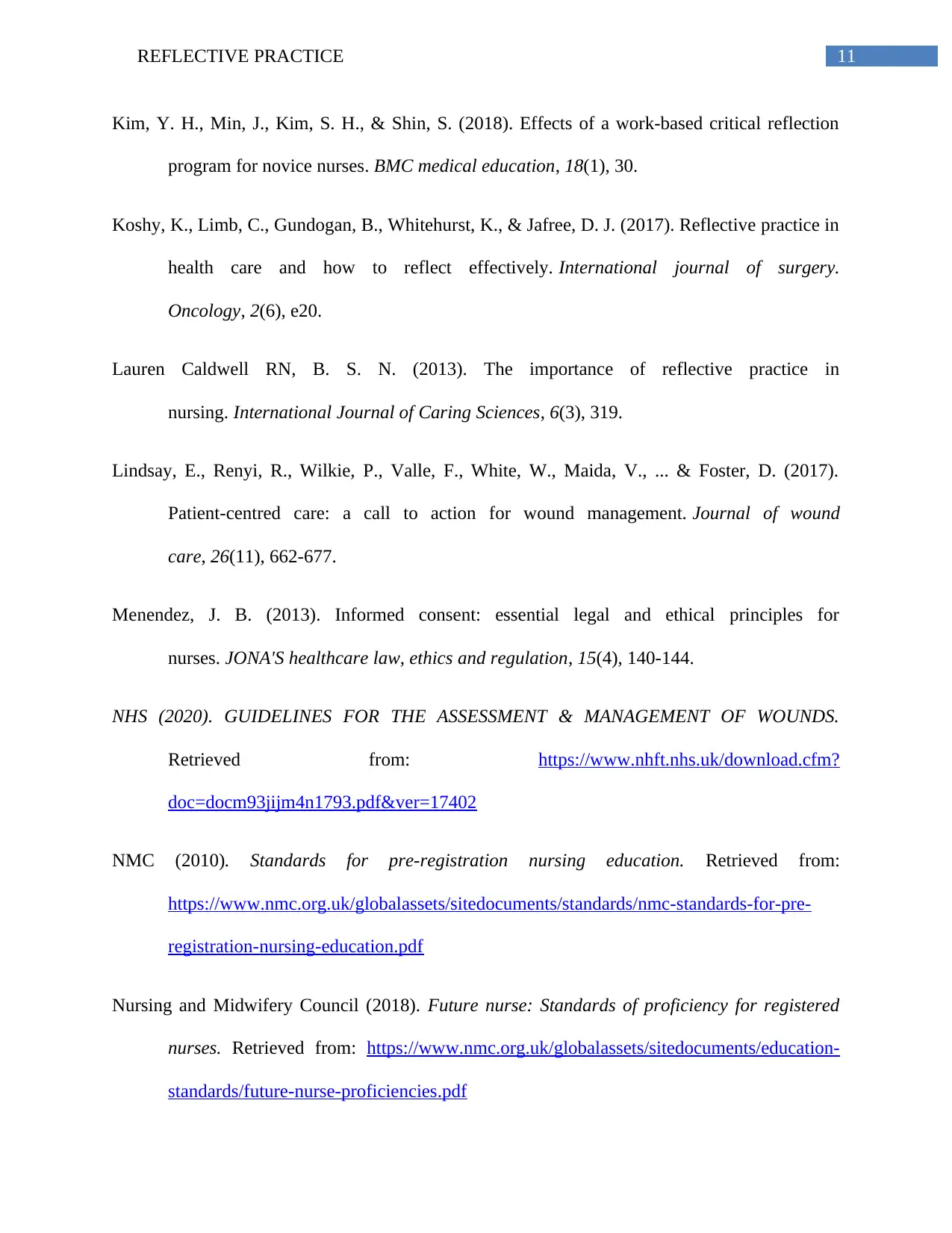
11REFLECTIVE PRACTICE
Kim, Y. H., Min, J., Kim, S. H., & Shin, S. (2018). Effects of a work-based critical reflection
program for novice nurses. BMC medical education, 18(1), 30.
Koshy, K., Limb, C., Gundogan, B., Whitehurst, K., & Jafree, D. J. (2017). Reflective practice in
health care and how to reflect effectively. International journal of surgery.
Oncology, 2(6), e20.
Lauren Caldwell RN, B. S. N. (2013). The importance of reflective practice in
nursing. International Journal of Caring Sciences, 6(3), 319.
Lindsay, E., Renyi, R., Wilkie, P., Valle, F., White, W., Maida, V., ... & Foster, D. (2017).
Patient-centred care: a call to action for wound management. Journal of wound
care, 26(11), 662-677.
Menendez, J. B. (2013). Informed consent: essential legal and ethical principles for
nurses. JONA'S healthcare law, ethics and regulation, 15(4), 140-144.
NHS (2020). GUIDELINES FOR THE ASSESSMENT & MANAGEMENT OF WOUNDS.
Retrieved from: https://www.nhft.nhs.uk/download.cfm?
doc=docm93jijm4n1793.pdf&ver=17402
NMC (2010). Standards for pre-registration nursing education. Retrieved from:
https://www.nmc.org.uk/globalassets/sitedocuments/standards/nmc-standards-for-pre-
registration-nursing-education.pdf
Nursing and Midwifery Council (2018). Future nurse: Standards of proficiency for registered
nurses. Retrieved from: https://www.nmc.org.uk/globalassets/sitedocuments/education-
standards/future-nurse-proficiencies.pdf
Kim, Y. H., Min, J., Kim, S. H., & Shin, S. (2018). Effects of a work-based critical reflection
program for novice nurses. BMC medical education, 18(1), 30.
Koshy, K., Limb, C., Gundogan, B., Whitehurst, K., & Jafree, D. J. (2017). Reflective practice in
health care and how to reflect effectively. International journal of surgery.
Oncology, 2(6), e20.
Lauren Caldwell RN, B. S. N. (2013). The importance of reflective practice in
nursing. International Journal of Caring Sciences, 6(3), 319.
Lindsay, E., Renyi, R., Wilkie, P., Valle, F., White, W., Maida, V., ... & Foster, D. (2017).
Patient-centred care: a call to action for wound management. Journal of wound
care, 26(11), 662-677.
Menendez, J. B. (2013). Informed consent: essential legal and ethical principles for
nurses. JONA'S healthcare law, ethics and regulation, 15(4), 140-144.
NHS (2020). GUIDELINES FOR THE ASSESSMENT & MANAGEMENT OF WOUNDS.
Retrieved from: https://www.nhft.nhs.uk/download.cfm?
doc=docm93jijm4n1793.pdf&ver=17402
NMC (2010). Standards for pre-registration nursing education. Retrieved from:
https://www.nmc.org.uk/globalassets/sitedocuments/standards/nmc-standards-for-pre-
registration-nursing-education.pdf
Nursing and Midwifery Council (2018). Future nurse: Standards of proficiency for registered
nurses. Retrieved from: https://www.nmc.org.uk/globalassets/sitedocuments/education-
standards/future-nurse-proficiencies.pdf
⊘ This is a preview!⊘
Do you want full access?
Subscribe today to unlock all pages.

Trusted by 1+ million students worldwide
1 out of 13
Related Documents
Your All-in-One AI-Powered Toolkit for Academic Success.
+13062052269
info@desklib.com
Available 24*7 on WhatsApp / Email
![[object Object]](/_next/static/media/star-bottom.7253800d.svg)
Unlock your academic potential
Copyright © 2020–2025 A2Z Services. All Rights Reserved. Developed and managed by ZUCOL.





